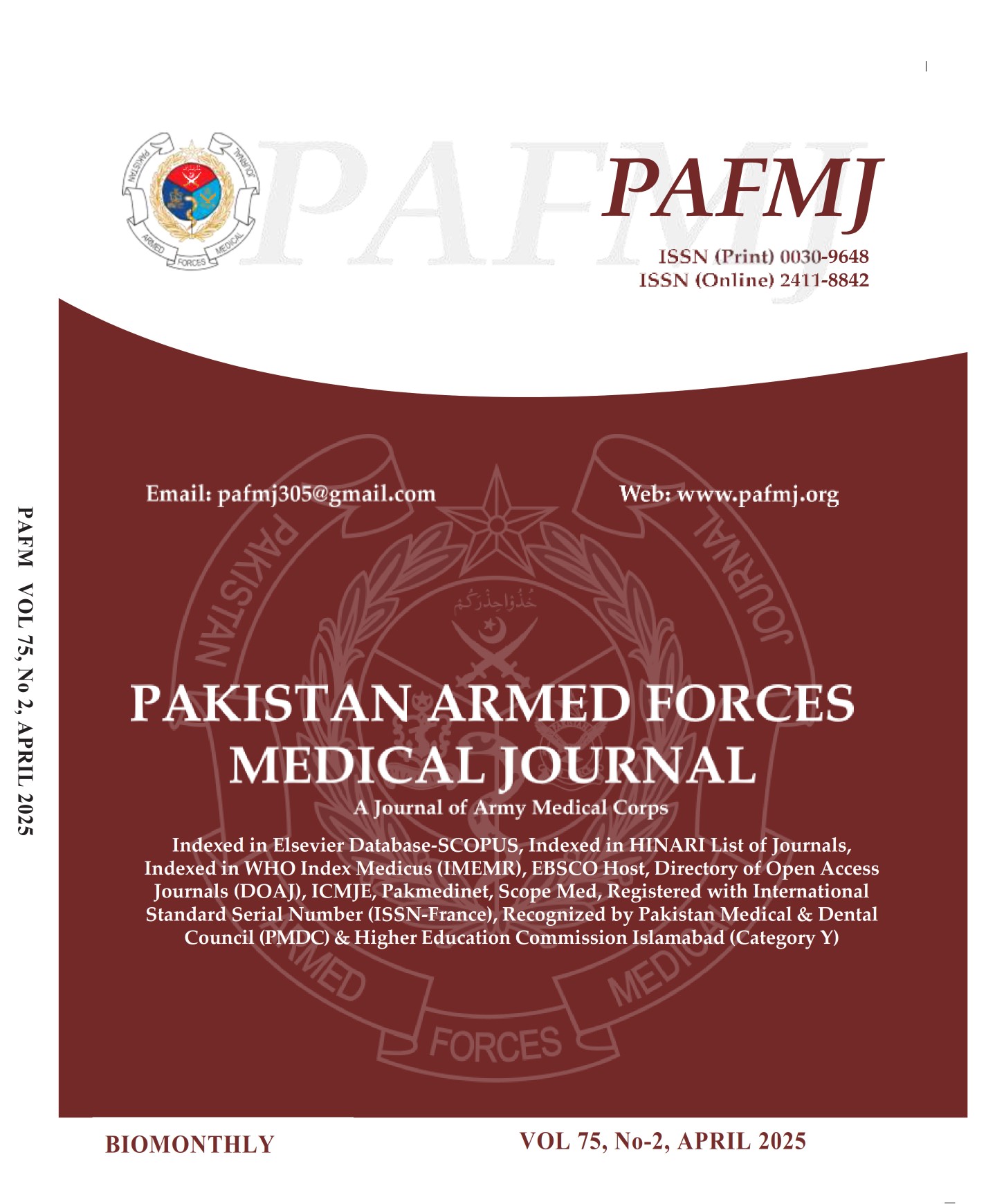Frequency of Peg Shaped Lateral Incisors in School-Going, Non-Syndromic Pediatric Population of Rawalpindi
DOI:
https://doi.org/10.51253/pafmj.v75i2.6841Keywords:
Incisors, Microdontia, Tooth AgenesisAbstract
Objective: To determine the frequency of peg-shaped lateral incisors in school-going, non-syndromic children of Rawalpindi.
Study Design: Cross-sectional study.
Place and Duration of Study: Operative Dentistry Department, Armed Forces Institute of Dentistry Rawalpindi, Pakistan from Dec 2019 Jan 2020.
Methodology: Three hundred and forty patients with age ranging from 6 to 11 years were taken from different schools of Rawalpindi. Oral-examination was performed by disposable-mirrors, torch and spatulas which included looking for the presence of peg-shaped permanent maxillary lateral incisors.
Results: Out of 340 children, 69% males and 31% females had peg laterals. In relation to age and school distribution, no statistically significant difference was seen between them (p=0.3, p=1.0). Quadrant-wise comparison revealed decreased incidence of single (6%) and increased bilateral peg-laterals in males (6% and 2% respectively) as compared to females.
Conclusion: The frequency of peg-laterals in children of Rawalpindi was 8.5% with greater occurrence in males.
Downloads
References
Hovorakova M, Lesot H, Peterka M, Peterkova R. Early development of the human dentition revisited. J Anat 2018; 233(2): 135-145.
https://doi.org/10.1111/joa.12825
Sharma A, Sharma D, Sharma M. Localized Microdontia: Unilateral Peg Shaped Mandibular Central Incisor. Int Healthc Res J 2019; 3(2): 59-61.
https://doi.org/10.26440/IHRJ/0302.05.521078
Chen Y, Zhou F, Peng Y, Chen L, Wang Y. Non-syndromic occurrence of true generalized microdontia with hypodontia: A case report. Medicine 2019; 98(26): e16283.
https://doi.org/10.1097/MD.0000000000016283
Khan EB, Fatima S, Rafi SM, Shah M, Ahmed HZ. Prevalence of Microdontia Among Patients Undergoing Orthodontic Treatment. Age. Liaquat Natl J Prim Care 2020;2(2):74-78. https://doi.org/10.37184/lnjpc.2707-3521.2.5
Alassiry A. An Evaluation of knowledge and preference of prosthodontic, orthodontic or integrated treatment options for peg shaped maxillary lateral incisors among general practitioners in Kingdom of Saudi Arabia-A Survey. Egypt Dent J 2018; 64(3): 2461-2468.
https://doi.org/10.21608/edj.2018.76825
Hussain S, Azeem M, Awan R, Ahmed A, Afif S, Shakoor U. The frequency of peg-shaped maxillary permanent lateral incisors among orthodontic patients of two health districts of Punjab, Pakistan. J Khyber Coll Dent 2018; 8(1): 59-62.
https://doi.org/10.33279/jkcd.v8i01.376
Yan HW, Sintian A. Prevalence of Permanent Maxillary Peg Shaped Lateral Incisors in Orthodontic Specialist Department Kota Kinabalu, Queen Elizabeth II Hospital. Malays Dent J 2020; 1(1): 59-73.
Gupta SP. Management of anterior spacing with peg lateral by interdisciplinary approach: a case report. Orthod J Nepal 2019; 9(1): 67-73. https://doi.org/10.3126/ojn.v9i1.25695
Mittal N, Mohandas A. Management of peg shaped lateral with new minimal invasive restorative technique:-componeer: a case report. Indian J Dent Adv 2018; 10(01): 53-55.
https://doi.org/10.5866/2018.10.10053
Alhabib S, Alruwaili A, Manay SM, Ganji KK, Gudipaneni RK, Faruqi S, et al. Prevalence of peg-shaped lateral incisors in non-syndromic subjects: a multi-population study. Pesqui Bras Odontopediatria Clín Integr 2020; 20(2): e0066.
https://doi.org/10.1590/pboci.2020.165
Amin F, Asif J , Akber S. Prevalence of peg laterals and small size lateral incisors in orthodontic patients – a study. Pak Oral Dent J 2011; 31(1): 88-91.
Hua F, He H, Ngan P, Bouzid W. Prevalence of peg-shaped maxillary permanent lateral incisors: a meta-analysis. Am J Orthod Dentofacial Orthop 2013; 144(1): 97-109.
Downloads
Published
Issue
Section
License
Copyright (c) 2025 Nasir Jamal Baig, Fahmeed Akhtar, Muzzamil Jamil Ahmad Rana, Mehmood Ahmad Rana, Mafaza Alam, Maham Wahid

This work is licensed under a Creative Commons Attribution-NonCommercial 4.0 International License.















